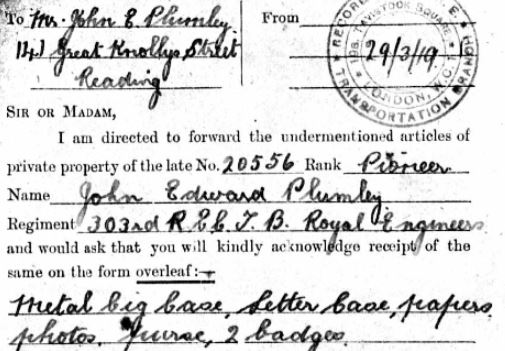Horace Lacey Pinker
Private 203760
1st/4th Royal Berkshire Regiment
 |
Private Horace Lacey Pinker was the son of John and Jane Pinker of Reading. He was killed 5th April 1917, aged 22. The 1901 census information indicates that his father was a master stone mason. The family were living at 69,London Road and it was from there that John Pinker ran his business. There were then three children with Horace being the middle child, older brother was called Stanley and the younger Harold. By 1911 Jane was a widow, still living at the same address. Horace is misrecorded as Florence and the census return also bears other mistakes. There is no occupation given for Horace and it is assumed that he is either still at school (he was then aged 15) or had no job.
At the time of his death actions were taking place between Cambrai and St. Quentin.
Private Pinker would have experienced the events which follow in the weeks leading up to his death. (Details are taken from Petre – History of the Royal Berkshire Regiment)
During misty weather in February 1917 the German army made its secret withdrawal to the Hindenburg line, masked by continuous shelling of the British positions. Allied Commanders had not fully realised the extent of the withdrawal but partial and curious retreats resulted in more raiding parties to collect prisoners and information. In March as the retreat became obvious and the 48th Division was in the forefront of the chase and open warfare once more took place. The 1st/4th’s reached Peronne on 20th March. The mudscape of the battlefields was now far behind and for the first time in many months the men were in open and green countryside where signs of spring breaking could be seen. The battalion engaged with the enemy again only as they approached the well defended Hindenburg line.
At the beginning of April the battalion was involved in fighting around Ephey and the village of Ronssoy where a heated battle took place and several men were also killed when the British barrage fell on them by mistake. It may be that Private Pinker was killed during this fighting. However, the spirits of the 1st/4th were high. After this battle the battalion moved back to Hamel for a rest, returning on 13th April to Ronssoy.
Private Pinker was buried at Templeux-Le-Guerard British Cemetery, the Somme. Grave location I. A. 13.

